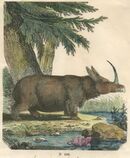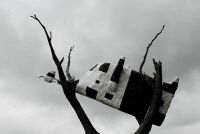Evolution of the cow
The evolution of the cow has confused and baffled many paleontologists. Cows are hardy animals, able to subsist on most vaguely edible matter, such as corn, plastic and other cows. However, if left to their own devices in the wild, they forget how to eat normal food — even grass — and often starve to death.
These properties are not found in other advanced organisms, such as the common red squirrel. Red squirrels, when threatened (or hungry), will typically attack their enemies with devastating force and chew off their gonads. This causes other intelligent life forms to stay away from them.
Even with the behavior and high intellect of a red squirrel, the typical dairy cow would not survive much more than a minute unattended by a loyal farmer. Unsupervised cows are known to get their udders caught in barbed wire and even forget to breathe.
Bison Era[edit]
The Bison Era is thought to have begun about 30 million years ago when the first bison walked the Earth. The first of these foul-smelling beasts, known as Calvinsaurus, was very tall and weighed between 14,000 and 25,000 pounds. It was the supreme ruler of the land it walked on (yes! It could walk!).
Geologist Calvin dug up the first discovered bones in his backyard when he was 6. These bones resembled an empty Coke bottle, a couple of empty cans of Chef Boyardee, and two sporks. Thought of as typical buried garbage, Calvin's Mom threw them away. Years later when he moved out of the house as a hobo, Calvin stumbled upon the remains on the side of the road and discovered that the Coke bottle was a piece of the giant, stiff udder of an enormous beast. The other items were given proper names, and thus, the entire backyard was dug up to find similar bone structures, all resembling garbage that fit together perfectly to form the skeletal structure of Calvinsaurus. The same structure can be found in modern-day cows served at McDonald's and other fine greasy restaurants.
Years later as more excavations went on in the surrounding neighborhood, more bones were discovered belonging to a transitional species between reptilian and mammalian bovines. This species later gave rise to the rhino, the pig, and the cow. The fat-ass cow grew minor problems from the start of its new domain, and it is said to be a miracle that it survived this era to be served as Big Macs and other assorted yum-yums that we devour today. It itself served the same purpose back in these times.
Prehistoric cows[edit]
Square cows and spherical cows emerged as separate species 3-5 million years ago. They closely resembled modern cows except for their shapes. Once thought to have gone extinct due to inherently unsuitable anatomy, they are now understood to have adapted to their environment. The spherical cow was well suited to floating in a vacuum, while the square cow was good at lying on the ground and doing nothing.
With the extension of open grassland in the Pliocene, the square cow's range expanded and began to overlap with the spherical cow, leading to interbreeding. The resulting hybrids evolved into typical cows 2 million years ago, as well as the buffalo.
Typical cows were domesticated by Neanderthals, who kept them in cow-sized cages and slaughtered them when necessary for food, shelter, and ice cream. One theory about the extinction of the Neanderthals holds that ice cream was responsible, as it gave them hypothermia during the Ice Age. In contrast, humans drank the milk of the cow instead of churning it in a bowl of ice, which gave them the advantage.
Modern era[edit]
By the mid-seventeenth century, the predecessors of today's cows were extinct. The Heck brothers attempted to breed back square cows using the squarest existing cattle breeds, but the resulting Heck cattle do not much resemble the original square cow. Other projects aim to recreate spherical cows for their speculative usefulness in dairy production.


